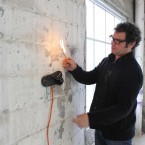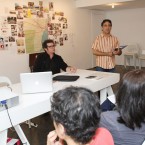Performance Beyond Miami’s Parties
by Paul David Young 12/06/11 Art in America.
The tenth edition of Art Basel Miami Beach was supposed to “reflect a shift toward expanded conceptual, performative and temporal gestures,” according to a curatorial statement. But there was little performance at the main fair, nor at the satellite fairs and events, unless you count the parties.
However, two lecture-performances provided a valuable opportunity to experience two sharply contrasting uses of this very current art form: Hennessy Youngman’s NADA-sponsored The History of Art Part 1 in the lobby of the Deauville Hotel on Dec. 1, and Ernesto Oroza’s Architecture of Necessity at the Fluxus-inspired exhibition “Four Minutes, Thirty-Three Seconds” at LegalArt, curated by Omar Lopez-Chahoud, on Dec. 2. The lecture-performance is often an ironic institutional critique of suspect curatorial practices, museum politics or art history. Terence Koh’s recurring Art History, for example, involves a rapid-fire series of images that he explains using incomprehensible babble.
Youngman is known for irreverent online videos that combine street talk and glib attacks on specialized art vocabulary, but History of Art Part 1 amounted to a sad commentary on the catchall of “art performance.” After several sound checks, the bearded Youngman, wearing a red Spiderman baseball hat, khaki shorts, gold chains, a BET leather bomber jacket and ankle boots, took his seat between some potted palms and began to read as a video projected behind him. Soon he announced that part of the script was missing, disappeared for a while and returned, without any additional material.
Youngman’s “history” began with the paper tiger of the artist as a mythic loner, a shaman “bringing magic into the world.” He railed briefly against the “MFA industry” of art education for producing “a creative class more like a search engine,” though, to the extent that he completed his performance, it was clearly itself a product of Google. He didn’t get very far before leaning into some racial comments about the crowd, a theme reprised throughout the performance. “Talking to a bunch of white people in the lobby is kind of weird. I need a lot of alcohol to cope with that.” Later, he said he saw “four brown people here” and described the audience as a “sea of milk with some chocolate chips in it.”
His refutation of the artist as lone protagonist was a belabored drug joke. He claimed that many historical figures, perplexingly mostly not from the history of art (the Incas, Pizarro, Thomas Edison, Sir Arthur Conan Doyle, Freud, Richard Pryor), had achieved something not because of “divine Providence” but because they had a “secret ally.” Then he trotted out pictures of work by Donald Judd and Carl Andre, facetiously asserting that they made their breakthroughs with the help of cocaine.
At this point, Youngman, bored, abandoned the lecture, turned off the video projection, and spent the rest of his time walking among the crowd, asking audience members general questions. “Are you an artist? A collector?” “Why are you here?” He warned the crowd, “Don’t come to NADA if you’re an artist because you’ll leave very depressed.” Youngman didn’t explain why that might be true. (In fact, the NADA fair was more vibrant than the main fair.)
Approaching one young woman, he inquired about the quality of his performance. “It’s pretty boring, right?” The woman sheepishly admitted, “A little . . . ” to which Youngman replied, “Should I just play music?”
He announced, “I’m going to keep doing this until you guys leave. This is called performance art.” Indeed, the eager crowd that had gathered was almost entirely gone by the time Youngman stopped the in-crowd interviews. The ending was hardly noticed by the people in the lobby who had wandered off to talk or drink the free Grolsch beer. To paraphrase Youngman, if this is performance art, it does require a lot of alcohol to make it tolerable.
By contrast, the unironic Ernesto Oroza, a Miami-based artist who resided in Cuba until four years ago, took his lecture entirely seriously, at least until he set fire to a pencil using live electric wires attached to a plastic sandal and then tried to operate a fan connected to a rotary telephone.
The pencil ignition was the illuminating conclusion to Oroza’s exploration of Cuban domestic innovation in response to the shortages and regulations of the Castro regime. Oroza was pleasantly low key, showing and describing rather than opining or advocating. An artist working with the ephemerality and low-tech predisposition of Fluxus, the raven-haired Oroza fingered his black plastic glasses, while operating his laptop and reading from a folded typed script that he had removed from his pocket.
Oroza explained how Cuban Marxism turns home ownership into a game of cat and mouse. With strict regulation on property ownership and construction, Cubans assert ownership piecemeal, establishing a stairway or extending the floor plan like a tendril to enclose a nearby freestanding wall. You can’t build a stairway, so you build ascending platforms that that functions as such, but is nonstandard enough to escape prohibition.
With a slideshow illustrating vernacular Cuban architecture, Oroza showed the absurd but delightful effects of this system. He illustrated its transformative potential through photographs of strange building fragments that he described as “the potential house.” A wrought iron handrail of an exterior staircase, breathtakingly irregular, had been created to avoid appearing to be a handrail. It curved in beautiful, organic curls, folding in, one on the other, not a stairway railing after all, but a primal kind of sculpture, site-specific and expressive of an individual will to overcome the impossible.
Oroza considered this “architecture of necessity” to be an instance of the total Cuban social adaptation to the island’s economic isolation, the most famous example of which is the country’s bizarrely well-preserved fleet of 1950s cars. For Oroza, this Cuban resourcefulness engenders a “pre-cultural sense of eating and sleeping,” a state that seemed momentarily desirable.
Oroza’s finale coaxed out the showman in him. Installed on the wall in the exhibition space of the superbly installed “Four Minutes, Thirty-Three Seconds” was Oroza’s black plastic sandal with two live wires protruding from it. Oroza placed a graphite pencil across the live wires and it burst into flames. He repeated the trick, explaining that this was a common practice in Cuba where there are no matches. Smokers set pencils on fire with electricity to light their cigarettes. (Don’t try this at home.) It was a vivid, comic illustration of human perseverance and a nice bit of stage pyrotechnics. After the final explosion, Oroza installed the burnt pencils in a row atop the electrical conduit feeding the socket, where they remain until the exhibition closes, Jan. 31.
- Light a fire with your house. Redrawing LegalArt’s building. Electrical system, pencil, plastic sandal, text on wall, action. 2011. © Kerry McLaney
- Ernesto Oroza lecture on Architecture of Necessity.

